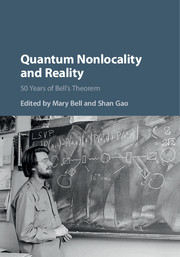Book contents
- Frontmatter
- Contents
- Contributors
- Preface
- Preface
- Part I John Stewart Bell: The Physicist
- Part II Bell's Theorem
- 4 What Did Bell Really Prove?
- 5 The Assumptions of Bell's Proof
- 6 Bell on Bell's Theorem: The Changing Face of Nonlocality
- 7 Experimental Tests of Bell Inequalities
- 8 Bell's Theorem without Inequalities: On the Inception and Scope of the GHZ Theorem
- Part III Nonlocality: Illusion or Reality?
- Part IV Nonlocal Realistic Theories
- Index
- References
6 - Bell on Bell's Theorem: The Changing Face of Nonlocality
from Part II - Bell's Theorem
Published online by Cambridge University Press: 05 September 2016
- Frontmatter
- Contents
- Contributors
- Preface
- Preface
- Part I John Stewart Bell: The Physicist
- Part II Bell's Theorem
- 4 What Did Bell Really Prove?
- 5 The Assumptions of Bell's Proof
- 6 Bell on Bell's Theorem: The Changing Face of Nonlocality
- 7 Experimental Tests of Bell Inequalities
- 8 Bell's Theorem without Inequalities: On the Inception and Scope of the GHZ Theorem
- Part III Nonlocality: Illusion or Reality?
- Part IV Nonlocal Realistic Theories
- Index
- References
Summary
Abstract
Between 1964 and 1990, the notion of nonlocality in Bell's papers underwent a profound change as his nonlocality theorem gradually became detached from quantum mechanics, and referred to wider probabilistic theories involving correlations between separated beables. The proposition that standard quantum mechanics is itself nonlocal (more precisely, that it violates ‘local causality’) became divorced from the Bell theorem per se from 1976 on, although this important point is widely overlooked in the literature. In 1990, the year of his death, Bell would express serious misgivings about themathematical form of the local causality condition and leave ill-defined the issue of the consistency between special relativity and violation of the Bell-type inequality. In our view, the significance of the Bell theorem, in both its deterministic and stochastic forms, can only be fully understood by taking into account the fact that a fully Lorentz covariant version of quantum theory, free of action at a distance, can be articulated in the Everett interpretation.
Introduction
John S. Bell's last word on his celebrated nonlocality theorem and its interpretation appeared in his 1990 paper ‘La nouvelle cuisine’, first published in the year of his untimely death. Bell was careful here to distinguish between the issue of ‘no superluminal signalling’ in quantum theory (both quantum field theory and quantum mechanics) and a principle he first introduced explicitly in 1976 and called ‘local causality’ [1]. In relation to the former, Bell expressed concerns that amplify doubts he had already expressed in 1976. These concerns touch on what is now widely known as the no-signalling theorem in quantum mechanics, and ultimately have to do with Bell's distaste for what he saw as an anthropocentric element in orthodox quantum thinking. In relation to local causality, Bell emphasised that his famous factorizability (no-correlations) condition is not to be seen ‘as the formulation of local causality, but as a consequence thereof’ and stressed how difficult he found it to articulate this consequence. He left the question of any strict inconsistency between violation of factorizability and special relativity theory unresolved, a not insignificant shift from his thinking up to the early 1980s.
- Type
- Chapter
- Information
- Quantum Nonlocality and Reality50 Years of Bell's Theorem, pp. 91 - 123Publisher: Cambridge University PressPrint publication year: 2016
References
- 4
- Cited by



